Nicolas Poussin, Landscape with a Calm, 1650-1
Source: Wikimedia Commons
Alain de Botton's recent ideas for making art more popular have not gone down well with the critics: '
pointless',
'smarmy and banal',
'merely stupid or simply patronising'. Perhaps an alternative to trying to engage with 'Art as Therapy', would be for more people to take a lead from T. J. Clark's unpromisingly-titled but highly rewarding book
The Sight of Death. The idea behind it was a simple one: to return repeatedly to an art museum (the Getty) and look at the two Poussin paintings I've reproduced here, engaging with them
as paintings and writing down each day's discoveries. Clark deliberately did not research them in advance, he just looked at them closely, in a way that any of us could. The result, as writer/psychotherapist Adam Philips wrote in his 2006
review, is more than just a detailed account of these landscapes, it is a book 'about what having a good look might mean at a time when most contemporary imagery, by showing us everything, doesn't want us to see too much'.
Nicolas Poussin, Landscape with a Man Killed by a Snake, 1648
Source: Wikimedia Commons
When you attend closely to a painting you start to appreciate all the choices the artist made - in Poussin, for example, there are his tiny details, like the two figures talking on the brow of the hill in
Landscape with a Man Killed by a Snake. This part of the painting is discussed in
The Sight of Death (in the entry for 13 April 2000) and I will quote a few sentences to exemplify the way Clark writes about it. Here he is thinking about the extent to which Poussin's details relate to the painting's overall structure:
'Right in the middle of the crisscross of greenery here Poussin suddenly interjects a partial opening into the sky, and not content with the offer of a roofline and white light that this enables, he puts a marvelous tiny square of white into the architecture, as if finally we are looking at the sky through an empty (ruined?) window. Or maybe somehow a pane of glass is glinting in the sun. The blip of white connects with one or two others close by, picking out the sky higher up in the foliage. But the window is essentially gratuitious - profoundly unnecessary, un-structural. It is pure delight.'
Clark's final entry in November 2003 is rather dispiriting.
Snake had been returned from the Getty, where it was on loan, to the National Gallery. There he encountered it hung right near the exit, in the Yves Saint Laurent Room, under 'lighting apparently borrowed from an indoor swimming pool in Tooting Bec'. He describes sitting, 'miserable and stupefied for an hour or so, listening to the songs played by the cell phones', along with the 'mild hysteria of twelve-year-olds' and their shushing teachers in the assembly area for school visits next door. He estimates that thirty-plus people a minute stream past Poussin's painting, 'one or two of whom give it a passing glance.' But, then, he reflects, this painting has suffered many indignities over the centuries, from the darkening effect of smoke to the pressure of a restorer's iron. He ends on note of optimism: 'one of these days
Snake will go on its travels again - back to Room 20 would be a start - daylight will catch it, and new viewers stop at the sight of death.'
Although not a new viewer, I did go and have a long look at
Snake on a rainy Bank Holiday afternoon this week, to see what new things I could see in it. I am happy to report that it is no longer in the Yves Saint Laurent room - that unfortunate spot now seems to be taken by Claude's
Landscape with Cephalus and Procris reunited by Diana. Instead it can be found in Room 19, surrounded by other Poussins and directly opposite the extremely sexy
Nymph with Satyrs. Of course I was not able to sit contemplating it undisturbed, but it was possible to ignore the groups of teenagers wondering through the room chatting. At one point an insistent ring tone was finally answered by a woman standing right in front of
Snake, but she was ushered away fairly quickly by an attendant. The National Gallery may not be as tranquil as the Getty, but I still spent a satisfying half hour in the company of
Snake.
The longer I looked the more I found to think about, and despite having read T. J. Clark's 260 pages I came away convinced I had seen one or two things he doesn't mention (for instance, that the postures of the three fishermen seem to rhyme with the running man, the washerwoman and her bag). Perhaps those visitors walking past me and ignoring all this would have been detained by a philosophical or therapeutic
post-it note, like those Alain De Botton has had placed around the
Rijksmuseum, although I like to think they really just needed persuading to stop for a while and look. As Anita Brookner points out in her
review of
The Sight of Death, Poussin himself is usually seen as a ‘peintre-philosophe’, but Clark shows us how he was also a pure maker. What the book demonstrates 'is that the best antidote to reading is looking.' This, she concludes, 'is the way to see pictures.'



































